Things to Do in Anaheim with Kids: A Comprehensive Guide
Anaheim, California is a popular tourist destination known for its theme parks, attractions, and sunny weather. For families with children, there are plenty of things to do in Anaheim that will keep everyone entertained. From thrilling rides to educational experiences, there is no shortage of activities to choose from.
One of the most popular attractions in Anaheim is the Disneyland Resort. This iconic theme park offers a magical experience for kids of all ages, with rides, shows, and character meet-and-greets. Families can spend a full day or more exploring the various lands, from Fantasyland to Tomorrowland.
Another theme park in the area is Knott’s Berry Farm, which offers a mix of thrill rides and family-friendly attractions. For a smaller, more budget-friendly option, Adventure City is a great choice. This amusement park offers rides, shows, and activities for younger children.
Key Takeaways
- Anaheim, California is a popular tourist destination with plenty of things to do for families with children.
- The Disneyland Resort is a must-visit attraction, with rides, shows, and character meet-and-greets.
- Other theme parks in the area include Knott’s Berry Farm and Adventure City.

Disneyland Resort
Disneyland Resort is one of the most popular attractions in Anaheim, especially for families with kids. The resort features two theme parks, Disneyland Park and Disney California Adventure Park, as well as Downtown Disney, a shopping and dining district.
Adventureland
Adventureland is one of the lands in Disneyland Park, and it is home to a variety of attractions that will keep kids entertained. The most popular ride in Adventureland is the Indiana Jones Adventure, which takes riders on a thrilling journey through a temple filled with booby traps and obstacles. Other popular attractions in Adventureland include the Jungle Cruise, which takes riders on a boat ride through exotic jungles, and the Enchanted Tiki Room, a musical show featuring singing birds and flowers.
Tomorrowland
Tomorrowland is another land in Disneyland Park, and it is dedicated to the future and space travel. Kids will love attractions such as Space Mountain, a high-speed roller coaster that takes riders through a dark and starry space, and Star Tours, a motion simulator ride that takes guests on a journey through the Star Wars universe. Other popular attractions in Tomorrowland include Buzz Lightyear Astro Blasters, where riders can shoot lasers at targets, and Autopia, where kids can drive their own cars.
Fantasyland
Fantasyland is a land in Disneyland Park that is dedicated to fairy tales and Disney characters. Kids will love attractions such as Peter Pan’s Flight, where riders fly over London and Neverland, and the Mad Tea Party, where guests spin in giant teacups. Other popular attractions in Fantasyland include the classic “it’s a small world” ride, where riders travel through different countries and cultures, and the Sleeping Beauty Castle Walkthrough, where guests can explore the story of Sleeping Beauty.
Mickey’s Toontown
Mickey’s Toontown is a land in Disneyland Park that is dedicated to the world of Mickey Mouse and his friends. Kids will love attractions such as Roger Rabbit’s Car Toon Spin, where riders spin around in cartoon cars, and Gadget’s Go Coaster, a kid-friendly roller coaster. Other popular attractions in Mickey’s Toontown include Mickey’s House and Meet Mickey, where guests can meet Mickey Mouse himself, and Minnie’s House, where guests can visit Minnie Mouse’s home.
Overall, Disneyland Resort is a must-visit destination for families with kids. With a wide range of attractions and entertainment options, there is something for everyone at the resort.
Knott’s Berry Farm
Knott’s Berry Farm is a popular amusement park located in Anaheim that offers a variety of rides, attractions, and shows for visitors of all ages. The park is especially great for families with kids, as it has several areas designed specifically for children.
Camp Snoopy
Camp Snoopy is a section of Knott’s Berry Farm that is dedicated to younger children. It features several rides that are suitable for kids, including the Balloon Race, Charlie Brown’s Kite Flyer, and the Grand Sierra Railroad. There are also several interactive play areas, including a playground and a water play area, where kids can cool off on hot days.
Ghost Town
Ghost Town is another popular section of Knott’s Berry Farm that is great for families with kids. This section of the park is designed to look like an old western town, and features several attractions that are both fun and educational. Visitors can take a ride on the Calico Railroad, explore the Mystery Lodge, or watch a gunfight at the OK Corral. There are also several shops and restaurants in Ghost Town, where visitors can pick up souvenirs or grab a bite to eat.
Overall, Knott’s Berry Farm is a great destination for families with kids who are looking for a fun and exciting day out. With its variety of rides, attractions, and shows, there is something for everyone to enjoy.
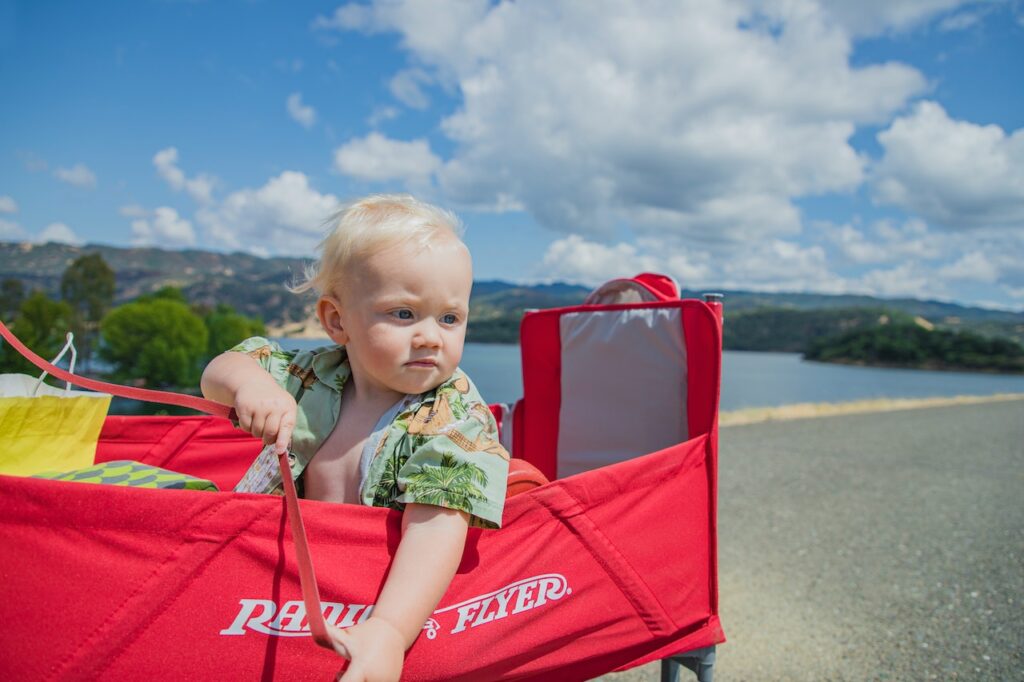
Adventure City
Located in the heart of Anaheim, Adventure City is a fun-filled amusement park designed for families with young children. With over 17 exciting rides, attractions, and shows, this park is perfect for families looking for a day of adventure.
Some of the most popular rides include the Crazy Bus, Rescue 911, and the Adventure City Express Train. The Crazy Bus is a spinning ride that takes you up and down, while the Rescue 911 is a thrilling ride where you get to save the day as a firefighter. The Adventure City Express Train takes you on a scenic tour of the park.
In addition to the rides, Adventure City also features a petting zoo, rock climbing, and a children’s theater. The petting zoo is home to a variety of animals, including goats, sheep, and rabbits, and is a great way for children to learn about animals and their habitats. The rock climbing wall is perfect for children who want to test their strength and agility, while the children’s theater features interactive shows that are sure to entertain the whole family.
Overall, Adventure City is a must-visit attraction for families with young children looking for a fun-filled day of adventure.
Anaheim GardenWalk
Anaheim GardenWalk is a perfect destination for families with kids who want to experience shopping, dining, and entertainment. The outdoor mall is located in the heart of Anaheim, just a few minutes away from Disneyland Resort.
The mall features a variety of stores, including fashion boutiques, sports shops, and gift shops. Kids will love the interactive stores like Build-A-Bear Workshop and Sephora, where they can create their own stuffed animals and experiment with makeup.
The dining options at Anaheim GardenWalk are also family-friendly. The mall has a variety of restaurants, from fast food to sit-down dining. The Rainforest Cafe is a popular choice among families with its unique jungle-themed atmosphere and menu.
Entertainment options at Anaheim GardenWalk include a state-of-the-art movie theater and a bowling alley. Kids will love the bowling alley’s neon lights and arcade games.
Overall, Anaheim GardenWalk is a great place for families to spend a day or evening. With its variety of shopping, dining, and entertainment options, there’s something for everyone to enjoy.

Anaheim Indoor Marketplace
The Anaheim Indoor Marketplace is a great place to take kids for a fun day out. This indoor shopping center has a variety of vendors selling everything from clothing to toys to jewelry.
One of the highlights of the marketplace is the food court, which features a variety of international foods. Kids will love trying new foods and experiencing different cultures. The food court also has plenty of seating, making it a great place to take a break and refuel before continuing shopping.
In addition to the food court, there are also several small restaurants and snack stands throughout the marketplace. These are perfect for grabbing a quick bite to eat while exploring the different vendors.
Parents will appreciate the ample parking and clean, well-maintained facilities. The marketplace is also wheelchair accessible, making it a great option for families with special needs.
Overall, the Anaheim Indoor Marketplace is a great place to spend a few hours with kids. With a variety of shopping options and delicious food, it’s sure to be a hit with the whole family.
Yorba Regional Park
Yorba Regional Park is a perfect spot for families who want to spend a day outdoors. With 140 acres of land, there’s plenty of space to run around and explore. The park is located in Anaheim, California, and is open every day from 7 am to sunset.
One of the main attractions at Yorba Regional Park is the lake. Visitors can rent paddle boats, row boats, and kayaks to explore the lake. Fishing is also allowed, but visitors must have a valid California fishing license.
For families who want to have a picnic, there are plenty of picnic tables and barbecue grills available. The park also has several playgrounds for children to enjoy.
In addition to the lake, Yorba Regional Park has several hiking and biking trails. These trails are perfect for families who want to explore the park and get some exercise. The park also has several sports fields, including baseball and soccer fields. To make it more fun, make sure the kids wear their favorite Baseball Jerseys or Soccer Jerseys to make their playtime more fun.
Overall, Yorba Regional Park is a great place for families to spend a day outdoors. With plenty of activities to choose from, everyone is sure to have a good time.
Oak Canyon Nature Center
Oak Canyon Nature Center is a hidden gem located in the heart of Anaheim. It is a 58-acre natural park that offers visitors the opportunity to explore the beauty of nature. The park has over 4 miles of hiking trails that wind through the canyons and hills, providing stunning views of the surrounding landscape.
The park is home to a variety of wildlife, including deer, coyotes, and many species of birds. Visitors can also explore the park’s many streams and ponds, which are home to a variety of fish and other aquatic animals.
Oak Canyon Nature Center offers a variety of educational programs for children and adults. These programs include guided hikes, nature walks, and wildlife presentations. The park also has a nature center that features exhibits on the local flora and fauna.
One of the highlights of the park is the annual Butterfly Festival, which takes place in the spring. During this event, visitors can learn about the life cycle of butterflies and even release their own butterfly into the wild.
Overall, Oak Canyon Nature Center is a great place to visit with kids. It offers a fun and educational experience that is sure to be enjoyed by the whole family.

Flightdeck Flight Simulation Center
Flightdeck Flight Simulation Center is a unique attraction in Anaheim that offers an exciting experience for kids and adults alike. The center provides visitors with an opportunity to experience what it is like to be a pilot and fly a plane.
At Flightdeck Flight Simulation Center, visitors can choose from a range of flight simulators that replicate real-life aircraft. The simulators are designed to give visitors a realistic experience of flying a plane, complete with takeoff, landing, and in-flight maneuvers.
The simulators are equipped with advanced technology that allows visitors to experience the sensation of flying a plane without leaving the ground. Visitors can choose from a variety of flight scenarios, including commercial flights, military missions, and aerobatic maneuvers.
In addition to the flight simulators, Flightdeck Flight Simulation Center also offers a range of other activities for visitors. These include a virtual reality experience, a museum, and a gift shop.
Overall, Flightdeck Flight Simulation Center is a must-visit attraction for anyone interested in aviation or looking for a unique and exciting experience in Anaheim. With its advanced technology, realistic simulators, and range of activities, it is sure to provide visitors with an unforgettable experience.
Conclusion
Anaheim is a wonderful destination for families with kids. From theme parks to museums, there are plenty of activities to keep everyone entertained. Here are some final thoughts on things to do in Anaheim with kids:
- Disneyland and Disney California Adventure are must-visit theme parks for families with kids. With rides, shows, and character meet-and-greets, there’s something for everyone.
- The Anaheim Packing District is a great place to grab a meal and explore local vendors. Kids will love the variety of food options and the lively atmosphere.
- The Discovery Cube Orange County is an interactive science museum that’s perfect for kids of all ages. With exhibits on space, dinosaurs, and more, there’s plenty to learn and explore.
- The Muzeo Museum and Cultural Center is a great place to learn about art and history. With rotating exhibits and special events, there’s always something new to discover.
- The Anaheim Ice rink is a fun place to go skating with the family. They offer public skating sessions and lessons for all skill levels.
Overall, Anaheim offers a wealth of activities for families with kids. Whether you’re looking for thrills or education, there’s something for everyone. With its sunny weather and friendly atmosphere, it’s no wonder that families come back to Anaheim year after year.
Frequently Asked Questions
What are some fun activities for kids at Adventure City in Anaheim?
Adventure City is a great place for kids to have fun. Some of the popular activities include riding on the roller coaster, playing mini-golf, and exploring the petting zoo. There is also a train ride, a carousel, and a rock climbing wall.
Are there any free activities for kids near Anaheim Garden Walk?
Yes, there are several free activities for kids near Anaheim Garden Walk. The Muzeo Museum and Cultural Center offers free admission on certain days of the week. The Anaheim Public Library also offers free events and activities for kids, such as story time and crafts.
What are some popular family-friendly restaurants in Anaheim?
There are many family-friendly restaurants in Anaheim. Some popular options include Rainforest Cafe, Medieval Times Dinner & Tournament, and The Cheesecake Factory. For a more casual dining experience, In-N-Out Burger and Denny’s are also great options.
What are some outdoor activities for kids to do in Anaheim?
Anaheim has many outdoor activities for kids to enjoy. Some popular options include visiting the Anaheim Hills Golf Course, hiking in the Anaheim Hills, and exploring Yorba Regional Park. There are also several playgrounds and picnic areas throughout the city.
What are some popular attractions for kids near the Anaheim Convention Center?
The Anaheim Convention Center is located near several popular attractions for kids. Disneyland and Disney California Adventure Park are just a short walk away. The Anaheim GardenWalk and Downtown Disney District also offer shopping, dining, and entertainment options for families.
What are some educational activities for kids to do in Anaheim?
Anaheim has several educational activities for kids to enjoy. The Discovery Cube Orange County offers hands-on exhibits that teach kids about science and technology. The Muzeo Museum and Cultural Center also offers exhibits and programs that teach kids about history and culture.
Carry On vs Personal Item: Understanding the Differences
Carry-on luggage and personal items are two types of bags that travelers often bring with them on flights. While both serve the purpose of carrying personal belongings, there are key differences between the two that travelers should be aware of before packing. Understanding these differences can help travelers pack more efficiently and avoid any complications at the airport.
Carry-on luggage is typically a larger bag that passengers are allowed to bring into the cabin with them. It must meet the airline’s size and weight restrictions and is stored in the overhead bin during the flight. Personal items, on the other hand, are smaller bags that passengers are allowed to bring with them in addition to their carry-on. These items must fit under the seat in front of the passenger. Knowing the difference between the two can help travelers pack more effectively and avoid any additional fees or complications at the airport.
Key Takeaways
- Understanding the difference between carry-on luggage and personal items can help travelers pack more efficiently.
- Carry-on luggage is typically a larger bag stored in the overhead bin, while personal items are smaller bags stored under the seat.
- Knowing the airline’s policies on carry-on luggage and personal items can help travelers avoid additional fees or complications at the airport.
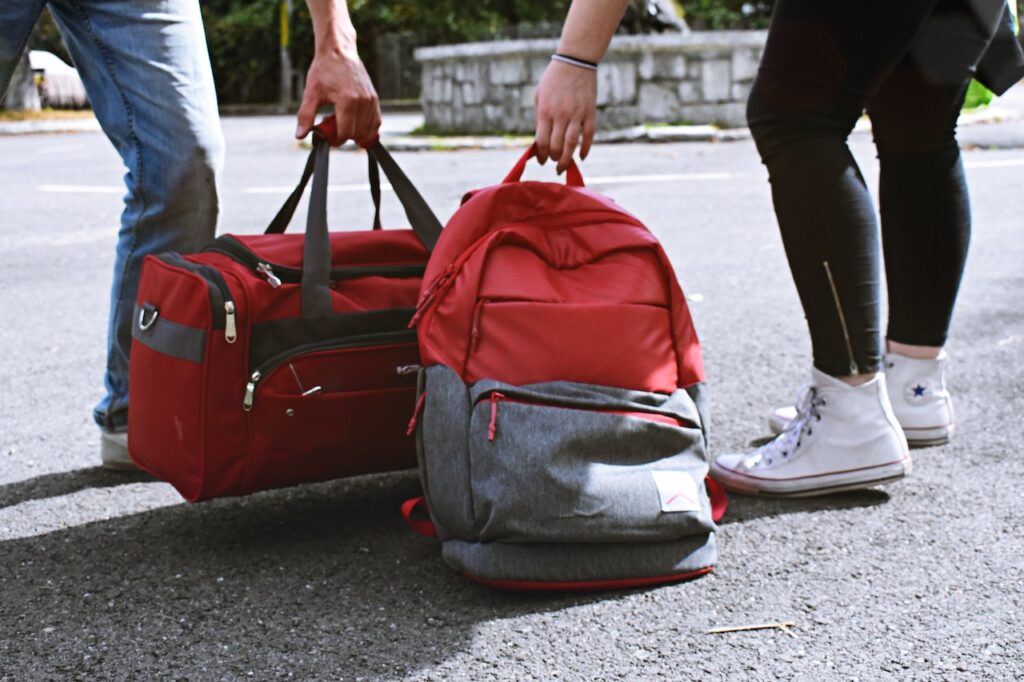
Understanding Carry on vs Personal Item
Definition of a Carry-On
A carry-on is a piece of luggage that passengers can bring onto the plane with them. It is typically stored in the overhead compartment or under the seat in front of them. Carry-on bags are limited in size and weight, and airlines have specific rules and regulations regarding what is allowed. The size and weight limits vary by airline, but generally, a carry-on bag must be no larger than 22 inches long, 14 inches wide, and 9 inches deep.
Definition of a Personal Item
A personal item is a smaller bag that passengers can bring onto the plane in addition to their carry-on. It is typically stored under the seat in front of them. Personal items are also limited in size and weight, and airlines have specific rules and regulations regarding what is allowed. The size and weight limits vary by airline, but generally, a personal item must be no larger than 18 inches long, 14 inches wide, and 8 inches deep.
Passengers are typically allowed to bring one carry-on bag and one personal item on the plane with them. Examples of personal items include purses, laptop bags, and small backpacks. It is important to note that some airlines may have different rules and regulations regarding what is considered a personal item, so it is always best to check with the airline before traveling.
In summary, understanding the difference between a carry-on and a personal item is important for travelers to ensure they are following airline rules and regulations. Passengers should be aware of the size and weight limits for both types of luggage and should check with the airline before traveling to ensure they are following all guidelines.
Key Differences Between Carry-Ons and Personal Items
Carry-on and personal items are both essential for air travel, but they serve different purposes. Understanding the differences between them can help travelers pack more efficiently and avoid unnecessary fees.
Size and Weight
Carry-on bags are larger and heavier than personal items. Most airlines allow carry-on bags to be up to 22 x 14 x 9 inches and weigh up to 40 pounds. Personal items, on the other hand, are usually smaller and lighter. They can be up to 18 x 14 x 8 inches and weigh up to 20 pounds.
Storage Location
Carry-on bags are stored in the overhead bin, while personal items are stored under the seat in front of the passenger. This means that personal items should be small enough to fit under the seat and not block the passenger’s legroom.
Types of Items Allowed
Carry-on bags can contain a variety of items, including clothes, electronics, and toiletries. However, there are restrictions on liquids and other items that may pose a security risk. Personal items are typically limited to items that can fit under the seat, such as a purse or laptop bag.
In summary, carry-on bags and personal items serve different purposes and have different size and weight restrictions. Travelers should pack accordingly to avoid fees and ensure a comfortable flight.

Airlines’ Policies on Carry-Ons and Personal Items
Common Airline Policies
When it comes to carry-on and personal item policies, airlines have varying rules and regulations. Generally, airlines allow passengers to bring one carry-on bag and one personal item on board. The carry-on bag should fit in the overhead bin and the personal item should fit under the seat in front of the passenger.
The size and weight restrictions for carry-on bags and personal items can differ from one airline to another. For example, American Airlines allows carry-on bags up to 22 x 14 x 9 inches and personal items up to 18 x 14 x 8 inches, while Delta Airlines allows carry-on bags up to 22 x 14 x 9 inches and personal items up to 17 x 13 x 10 inches.
It’s important to check the airline’s website for specific rules and regulations regarding carry-on bags and personal items. In addition, passengers should be aware that some airlines may charge fees for carry-on bags or personal items.
Exceptions and Special Cases
There are some exceptions and special cases when it comes to carry-on and personal item policies. For example, some airlines may allow passengers to bring additional items on board, such as a jacket, umbrella, or duty-free shopping bag.
Passengers traveling with infants or small children may also be allowed to bring additional items on board, such as a diaper bag or stroller. However, it’s important to check with the airline beforehand to ensure that these items are allowed and meet the size and weight restrictions.
Passengers with disabilities or medical conditions may also be allowed to bring additional items on board, such as a wheelchair, medical equipment, or a portable power wheelchair. Again, it’s important to check with the airline beforehand to ensure that these items are allowed and meet the necessary requirements.
Overall, it’s important for passengers to familiarize themselves with the airline’s policies on carry-on bags and personal items to avoid any issues or fees at the airport. By following the rules and regulations, passengers can ensure a smooth and stress-free travel experience.
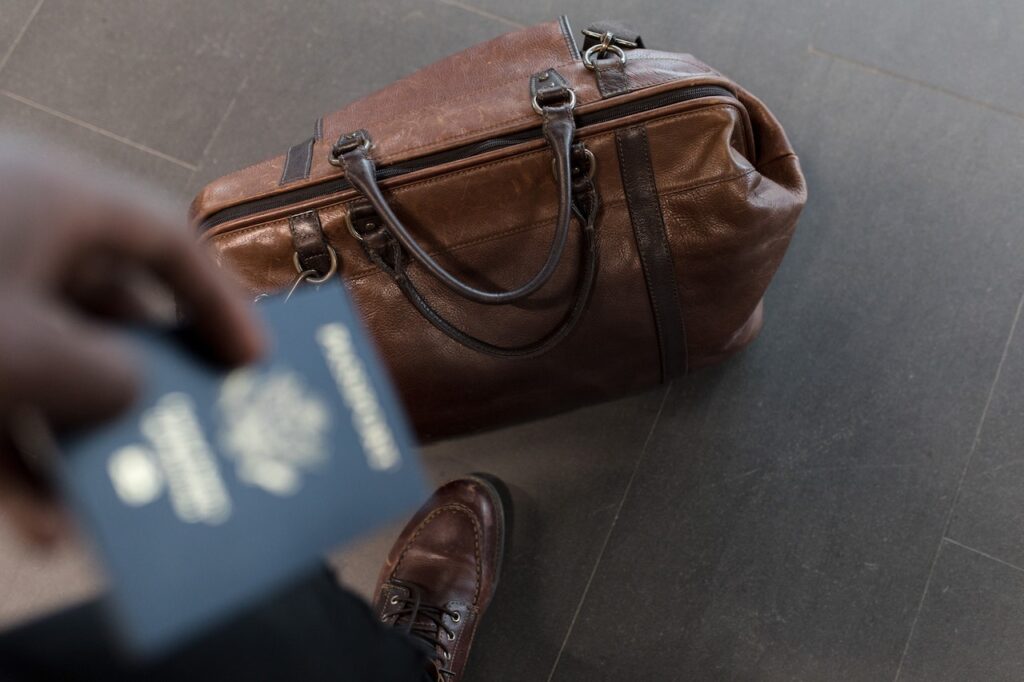
Tips for Choosing Between a Carry-On and Personal Item
When it comes to packing for a trip, deciding between a carry-on and personal item can be a difficult decision. Here are some tips to help you make the right choice:
Consider Your Travel Needs
The first thing to consider is your travel needs. If you are traveling for a short trip, a carry-on may be all you need. However, if you are traveling for a longer period of time, you may need a personal item in addition to your carry-on.
Consider the purpose of your trip and what items you will need to bring with you. If you are traveling for business, you may need to bring a laptop and other work-related items, which may require a personal item. If you are traveling for leisure, you may only need a carry-on for your clothing and other essentials.
Understanding Airline Restrictions
Another important factor to consider is airline restrictions. Each airline has its own rules and regulations regarding carry-on and personal items, so it’s important to check with your airline before you pack.
Most airlines allow a carry-on bag that is no larger than 22 x 14 x 9 inches and a personal item that is no larger than 18 x 14 x 8 inches. However, some airlines may have different size restrictions or weight limits, so it’s important to check with your airline before you pack.
In addition to size restrictions, some airlines may also have restrictions on the types of items you can bring in your carry-on or personal item. For example, liquids must be in containers that are 3.4 ounces or less and placed in a clear, plastic, quart-sized bag. Other items, such as sharp objects or firearms, may not be allowed in your carry-on or personal item.
By considering your travel needs and understanding airline restrictions, you can make an informed decision on whether to bring a carry-on or personal item on your next trip.
Conclusion
In summary, choosing between a carry-on and personal item depends on the traveler’s specific needs and preferences. Both options have their advantages and disadvantages, and it ultimately comes down to what the traveler deems essential for their trip.
Carry-on bags offer more space and are ideal for longer trips or those who prefer to pack more items. They are also easier to maneuver through the airport and eliminate the need for checked luggage, which can save time and money. However, they may not fit in overhead compartments on smaller planes, and airlines may charge extra fees for larger bags.
On the other hand, personal items such as backpacks or purses are smaller and more convenient for shorter trips or those who prefer to travel light. They are also more versatile and can be used for day-to-day activities during the trip. However, they may not provide enough space for all necessary items and can become uncomfortable to carry for extended periods.
Ultimately, the decision between a carry-on and personal item comes down to personal preference and travel needs. It is important to consider factors such as trip length, destination, and airline regulations before making a decision. By carefully weighing the pros and cons of each option, travelers can make an informed decision and ensure a smooth and stress-free travel experience.
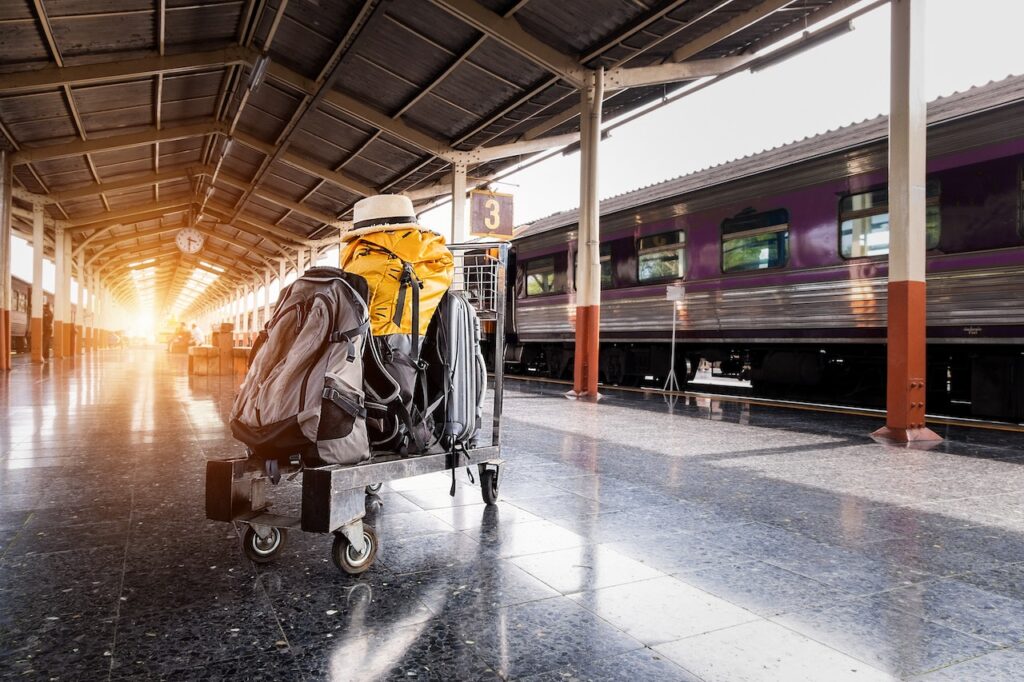
Frequently Asked Questions
What is the difference between a carry-on and a personal item?
A carry-on bag is a larger bag that can be stowed in the overhead bin of an airplane. On the other hand, a personal item is a smaller bag that can be placed under the seat in front of you.
What are the size restrictions for a carry-on bag and a personal item?
The size restrictions for a carry-on bag vary by airline, but generally, the maximum size is around 22 x 14 x 9 inches. For a personal item, the maximum size is usually around 18 x 14 x 8 inches.
Can I bring a backpack as a personal item?
Yes, you can bring a backpack as a personal item as long as it meets the size requirements set by the airline.
What items are allowed in a personal item bag?
You can bring a variety of items in a personal item bag, including a laptop, a book, a small purse, a camera, or any other small item that can fit under the seat in front of you. However, it’s important to note that liquids, gels, and aerosols must be in containers that are 3.4 ounces or less and placed in a clear, plastic, quart-sized bag.
Which airlines allow both a carry-on and a personal item?
Most airlines allow both a carry-on bag and a personal item. However, the size restrictions may vary by airline, so it’s important to check with the airline before you travel.
What is the best personal item bag for air travel?
The best personal item bag for air travel is one that is lightweight, durable, and has enough compartments to keep your belongings organized. Some popular options include backpacks, tote bags, and messenger bags.
Everything You Need to Know About Office Removals Insurance
It is tiring to move from one place to another in the same city. The process begins by packing up office furniture and moving it to the van. It is important that the removal process be smooth and easy to follow. Insurance for office removals is an essential aspect to any workplace relocation. It offers financial protection against losses, damages or accidents that might be incurred during the relocation process.
Many people have made the mistake of damaging household items during a move. You can’t take care of everything you own all the time. It’s a good idea to hire Removalists Sydney to Melbourne and purchase removal insurance before moving.

What Kind of Insurance Do I Need when moving my office
Depending on the service, it may be mandatory or optional to purchase removal insurance. Do you need to consider insurance for your items, regardless of whether you are moving locally or interstate? Consider the possible difficulties that you may face. Do you have the guts to accept that if something breaks and an agreement prevents reimbursement of replacement or financial damage to the damaged items, it is not your fault?
It is important to know that even though some insurance policies may be expensive, they cover all of your belongings.
Which types of removals insurance cover?
Below you will find a list of useful links.
Full service insurance that covers all risks, including driving and loading:
This class offers the most comprehensive coverage. This insurance can be used to move things within the city or from one country.
Create a list with the items that you want to be covered and make sure to replace them. Interstate removalists Sydney will help you classify your items for insurance, like office furniture. You will get an average price for each category. Also, they provide a value for a replacement.
For some items, you can receive a full replacement, while for others you will need to provide a certain amount as a replacement for the damage that was done to the item.
Full Service Insurance (They Load and Drive):
It also includes the payment of damages when the products move. Terms and conditions must be strictly followed. The delivery of the product and the storage time are covered. You can recover any damage that occurred to the product during storage.
This type of insurance doesn’t cover damage to goods during loading or unloading. To ensure the smooth running of this process, it is important to hire professional removalists Sydney to Canberra.
Insurance companies further divide their offerings into categories, which cover specific items and pay insurance based on total value. You must choose the items you want to insure and then create a proposal for a replacement. This policy can also be used to cover a work location.
The price of the product includes insurance for the whole shipment. You then add up all the items you want to cover and estimate how much it will cost.
Insurance against total loss:
Insurance can cover damages caused by a catastrophe, like a fire, accident or theft of the entire vehicle. You can get compensation if you lose things due to such accidents. Loss is covered but no compensation is given for individual items that were damaged.
This type of insurance provides a more affordable estimate than other types. Before moving furniture or other belongings, you can get a comprehensive insurance policy. You have two days to pack your belongings and you will need the help of a professional moving company.
Truck Rental Insurance Coverage:
The best insurance for transporting goods between cities is this type of policy. This insurance covers damage only that occurs during transportation. The damage doesn’t have to be caused by an accident or stolen. You won’t be compensated for damage to your car. You only get reimbursed for the cost of shipping the items.
The insurance does not cover damage to goods that occurs during loading or unloading. The insurance options are also divided into different inventories and total value. Select the items that you want to protect, and then select an alternative offer. Total value: Determine the total value and coverage of all items.

What happens if I pack the items myself?
Insurance companies will not cover any damages or losses, even if the boxes were packed by you.
You will only be liable for a limited amount of money if you pack your own items (PS40 per item or carton). If you pack your own items, no full transit will be provided.
The removal company cannot see what is inside your boxes, and they can’t verify any claims that may arise about damaged or missing goods.
If you are in need of packing services, many removal companies offer them.
What will happen if a mover breaks something?
Accidents can occur during or prior to moving. The moving company may have accidentally dropped a fragile furniture piece. Even if it was an accident, the moving company must be held responsible. If the client is upset, a rebuke might not be enough to calm them down.
The removal company must ultimately pay for damaged or broken items. Some removal firms sign agreements that stipulate that payments for damaged goods are not accepted. This could lead to legal action or damage to your local professional’s reputation. It is for this reason that removal companies prefer to provide insurance in order to protect their business and ensure the safety of your possessions.
Conclusion
Office removals insurance can be a vital safeguard for the relocation process. Understanding the different types of insurance coverage, reviewing policies and taking preventive steps can help you ensure that valuable assets are covered and that your move will go smoothly.
Homeowner Happiness: It’s a Real Thing!
If there’s one thing we can all agree on when it comes to buying a home, it’s that it can be quite stressful. In real estate, there is not just the overall stress relating to getting the money together for a down payment, but the psychology of buying a house is something that provokes a number of key questions, namely, is buying a house a key to happiness? Here are a few things that can contribute to homeowner happiness.
The Sense of Accomplishment
The shopping for mortgage quotes may seem like a lot of admin work, but it’s critical to remember that, while hunting for houses can seem like a part-time job all in itself, when you get accepted for a mortgage there is that sense of happiness because shopping for a house means that you are finally getting some sense of stability.
Homeownership can provide that sense of rootedness and belonging because it’s a place to call your own. The potential for financial benefits is also significant. Of course, it’s not guaranteed, but buying a house means that you are now in a position to build equity and benefit from property value appreciation. If you are looking at your first home, the achievement of getting onto the property ladder can give you peace of mind in the long run. However, it’s important to keep up with mortgage repayments and contribute to the overall value of the property by making upgrades and improvements. This will contribute to your sense of belonging and, ultimately, happiness.

Connection and Community
It’s not just about owning a property but also being part of a community and establishing connections with neighbors. While there can always be troublesome neighbors, when searching for a property for you and your loved ones, it’s important to consider the placement of the property in terms of setting up a family home. Feeling a sense of belonging will contribute to your well-being and happiness over time.
Being House Proud
It’s a sense of pride and accomplishment that comes with owning your own home. Being house proud is something that you may not understand until you have your own place. When you rent a property, you may not feel as inclined to take care of it in the same way as you would with your own home. Regular house cleaning doesn’t just become something that contributes to the overall maintenance but it’s something that you will actively want to do, within reason of course. Also, being house proud is also linked to a greater sense of well-being because you will feel more responsible, and this can ultimately drive some sense of purpose. We should feel relaxed in our home, and this is not always the case if there is a lot to do. But the one thing that can override all of this is the fact that we’ve got a place that is ours and nobody else’s. Homeowner happiness is something that we should all strive towards and not just view our property as a commodity, but actually something that will contribute to our sense of self.
4 Incredible Hen Party Trip Ideas
For many would-be brides, the hen party is the stuff of dreams – a way to forget about the stresses of wedding planning for one last night of fun with their closest friends. But if you’re looking for something special and don’t want a traditional night out, why not plan an unforgettable trip away?
Rather than head to your local city centre with obligatory blow-up models and a variety of flashing lights, why not ensure your hen do is really one to remember by going the extra mile, and guaranteeing an amazing night that none of your friends will ever forget?
Looking for inspiration? Then read on to uncover four of our top hen party ideas, and prepare to party like you’ve never partied before!

- Take A Luxury Beach Getaway
Nothing screams “hen weekend” quite like a beach getaway – but why not take this to the next level by investing in a trip to somewhere more exotic?
Whether you fly to the Maldives with its white sands and crystal-clear waters, hotfoot it to Florida to make the most of the Miami surf, or opt for the classic hen-party hotspot of Magaluf, heading away to the beach will do more than help you top up your tan prior to your big day.
A longer trip can be the perfect way to connect with your bridal party before you start married life – and this is an ideal way to ensure you have plenty of time to relax, catch up and make the most of some pre-wedding bonding.
Make sure you pick up some beautiful swimwear to make the most of your beach trip – you could even select matching outfits to help add an extra special touch – and organise a range of activities you are all certain to enjoy.
By the time you come home, you’ll feel refreshed, relaxed and ready to start your wedding planning all over again.
- Take A City Break To Somewhere Brand New
If you’re looking for a slightly more urban experience, why not head away on a city break? Jet off to a city that is totally new to the whole gang, or opt for an old favourite to relive some good times, and make brand new memories.
Whether you plan a few days in Paris to soak up the sights, take an unforgettable trip to Rome or head to Barcelona for a night of tapas and sangria, a city break offers the perfect opportunity for you and your bridal party to explore something new.
City breaks can be tailored to suit every budget – and if you’re looking for something even more exclusive, it’s worth investing in a VIP experience. From helicopter tours of London to personalised shopping experiences in Paris, there are plenty of ways to make your city break truly unforgettable.
- Experience An Unforgettable Activity Break
If you’re looking for an even bigger adventure – and a hen party with a real twist, then why not consider a hen party activity break? This is a perfect change to unleash your adventurous side and try something brand new, challenging yourselves to the limits before you take the leap and make the ultimate commitment through marriage.
Perhaps you and your gang of hens fancy trying your hands at surfing, kayaking or even white-water rafting? Or perhaps a spot of skiing or snowboarding is more your thing?
If you are keen to try out multiple adventures, you could even take things one step further by booking an adventure or survival type experience. These are dedicated trips where you can try out a range of activities from archery to abseiling, and are ideal for those would-be brides who need an adrenaline rush on the run up to their big day.
As a bonus, why not try out a survivalist course, or even a bushcraft session? Not only does this totally push you out of your comfort zone and let you try something new, but it also offers a real chance to bond in a unique and memorable way. You will be able to connect and make memories while pulling together to achieve a common goal, or perhaps master a new skill and learn something totally different – the possibilities really are endless.
- Enjoy An Amazing Party Holiday
If you and your hens are fans of a good night out, why not take things one step further by booking the ultimate party holiday? This is the perfect choice for hens who want to make sure they’re partying until the wee small hours – and if you and your gang are keen to really let loose in a safe environment, look no further than one of the many specially organised hen party trips.
Companies such as Party Hard Travel take the hard work out of organising a hen weekend, and offer a range of incredible packages. From the best Aiya Napa events in 2023 to tearing up the dancefloor in Magaluf, Party Hard Travel’s dedicated team will arrange everything from accommodation and travel to entry into the hottest clubs – so you can focus on having an amazing time with your bridal party.
The great thing about these trip packages is that they take all of the hassle out of organising a night out – and depending on the destination that you choose, you can enjoy a range of different activities during the day, before settling in for a night of dancing and drinks.
From Ibiza to Barcelona, and from Magaluf to Ayia Napa, there are plenty of fantastic party destinations that offer something truly unique.
How To Choose The Perfect Hen Party
So, just how do you go about putting together the perfect hen party? Here are a few tips to help you make sure your event is an unforgettable one:
- Decide on a Budget
Before you start planning, it’s important to decide on a budget so that you know what kind of activities and accommodation you can afford. Have a clear understanding of what you can afford, and you will be able to make the most of your planning to find the perfect trip.
- Consider Your Location
Think about where you would like to go and what kind of activities you can do in that area – we have set out four very different options above, so see which is the best fit for you and your group.
- Gather Everyone’s Ideas
Get everyone involved in the planning process and get their input on where to go, what to do and what kind of accommodation is best. This will help ensure the whole group has a good time, and reduce the risk of conflict or drama.
- Stay Organised
Make sure you stay organised throughout the planning process and make sure everything is booked and confirmed in advance. Alternatively, why not outsource this to your chief bridesmaid to allow you to relax and enjoy the trip?
- Have Fun
Most importantly: don’t forget to have fun! It’s your hen party, so make sure you enjoy every moment of it before you take your first steps into married life.
Final Thoughts
Your hen party is an amazing chance to get together with your girlfriends, celebrate your upcoming nuptials, and make the most of this important transition to marriage.
With our tips and inspiration above, you can help ensure your hen party is one to remember, for all the right reasons. Whether you’re a party animal or one for beachside luxury, or have other tastes or preferences for a hen party, the possibilities are close to endless. So, make sure you get planning early to maximise the chances of your hen party being “just right” in every way.
8 Essential Things to Pack on Your Solo Trip
Traveling solo can be one of the most exhilarating experiences of your life. Whether you are exploring a new city, hiking through remote wilderness, or simply taking some time to recharge, solo travel allows you to fully immerse yourself in the experience. Travel enthusiasts and nature lovers are often seen as backpackers hovering in places with less to no interest. It is just like an addiction that only the solo traveler understands. But before you embark on your solo adventure, it’s important to pack the right essentials. Here are some things to pack while going for a solo trip.
Proper Documentation
Prior to embarking on your solo journey, it’s essential to ensure you have all the necessary documentation in order. This includes your passport, visa (if needed), travel insurance, and any other vital documents necessary for your destination. Checking the publix.com passport platform for updates and requirements is also recommended. Additionally, if you plan to bring your bike to remote or unfamiliar locations, it’s crucial to have the required documents to enhance the safety and enjoyment of your journey.
Appropriate Clothing
Pack clothes that are suitable for the climate and activities you will be doing. Whether you are going to some deserts or the chilly mountains, research the weather of your destination in recent times and pack your clothes accordingly. Sometimes you may have be with a hot and sexy San Juan escorts, so comfortable shoes, a rain jacket, and a hat are some of the essential items you should consider packing. You never know what is waiting for you in the mid of the rainforests. Also, make sure to pack clothing that can be layered for versatile use.
First-aid Kit
When you are alone, you don’t know what might hurt you. Sometimes a simple scratch may be sore and become something problematic. A basic first-aid kit is a must-have for any solo traveler. This should include band-aids, antiseptic wipes, painkillers, insect repellent, sunscreen, and any other medication you might need. It is always better to be prepared for any emergency. At times, chocolates also work when you have mild heartaches or you miss your dear ones. As the saying goes, “Prevention is better than cure”.
Travel-sized Toiletries
Maintaining good hygiene, whether you are moving alone or with someone is very much important. Small things like cleanliness matter quite a lot when you are on a solo trip. People who go on frequent solo trips save space by packing travel-sized toiletries such as toothpaste, toothbrush, shampoo, conditioner, soap, and moisturizer. You can also buy travel-sized bottles and fill them with your favorite products. Don’t miss out on the essential things that help you when no one is around.
Portable Charger & Power bank
The only mode of communication with your friends and relatives is your mobile phone and other gadgets. If you find the battery of such gadgets dead, it would be the worst thing you can expect. So, carrying a portable charger and power bank is essential for solo travelers, especially when you are constantly on the move. If you desire to meet an Edinburgh call girls to fulfill your fantasy, you must the required access. Moreover, the chargers also help you in keeping your camera’s battery alive so that you can capture the lonely yet beautiful movements you come across. This will ensure your phone and other devices stay charged and you stay connected.

Travel Journal
Even if you don’t have a knack for writing, pen down your experiences. Later, when you turn back these notes will help you revisit the places in your memory. A travel journal is a great way to capture your experiences, thoughts, and feelings during your solo trip. It is a great way to remember the amazing experiences you had and also helps you reflect on your solo journey. Nowadays, people use specific templates to copy down their experiences; you can use them. If you love clicking pictures then your that hobby will also be a great help.
Money &Travel Card
Traveling solo also requires adequate monetary funds. When you are alone in some distant place and you cannot figure out the way further money helps. Moreover, for your night stays and scrumptious meals, you require money and travel cards to help you. Make sure you have enough cash and a travel card for emergencies. It is also wise to carry a separate debit or credit card in case of theft or loss. Although money cannot buy you comfort it definitely helps you spend a chilly night far from your home.
Maps & Guidebooks
While digital maps and guides are handy, it’s always good to carry a physical map and guidebook as a backup. This will ensure you never get lost and can always find your way around whether you are traveling solo or with stunning escorts from Gold Coast. People often get stuck in the middle of horrific passes and routes when they don’t have a manual map or something like that. At such places, you even may get someone helping you with gas or a drip of water. So it is always advised to have a backup plan and carry a guidebook or map to help you.
In conclusion, solo travel can be a liberating and life-changing experience, but it’s important to be prepared for any situation. Carrying some snacks and water is also a good idea, especially if you are going on a hike or exploring remote areas. This will ensure you stay hydrated and energized throughout your journey. And, lastly, it’s always important to be prepared for any situation. Carrying personal safety items such as a whistle, pepper spray, or a small flashlight can give you a sense of security and protect you in case of danger. By packing these essential items, you can ensure a comfortable and safe journey while making the most of your solo adventure. So, pack your bags and embark on your journey with confidence!
Struggling to book? Features to look for in a great hotel
It can’t be controversial to say that not all hotels are created equal. From the most luxurious of the luxurious, like the seven star hotels of Dubai, to the slightly run down local bed and breakfast with a winking ‘vacancies’ sign, every hotel has something different to offer and suits a different budget and holiday style.
If, for your next holiday, you’re planning to stay at a nice hotel, then it’s definitely important to be sure you’re spending your money correctly and do a bit of research beforehand. And before you even do that, how do you know what you’re looking for? Are you interested in all-inclusive? Excursions being offered? Or do you want to just relax and spend time in a resort? To help you work out what you want from your hotel experience, we’ve created this handy list of possible hotel features so you can think about which ones resonate with you.
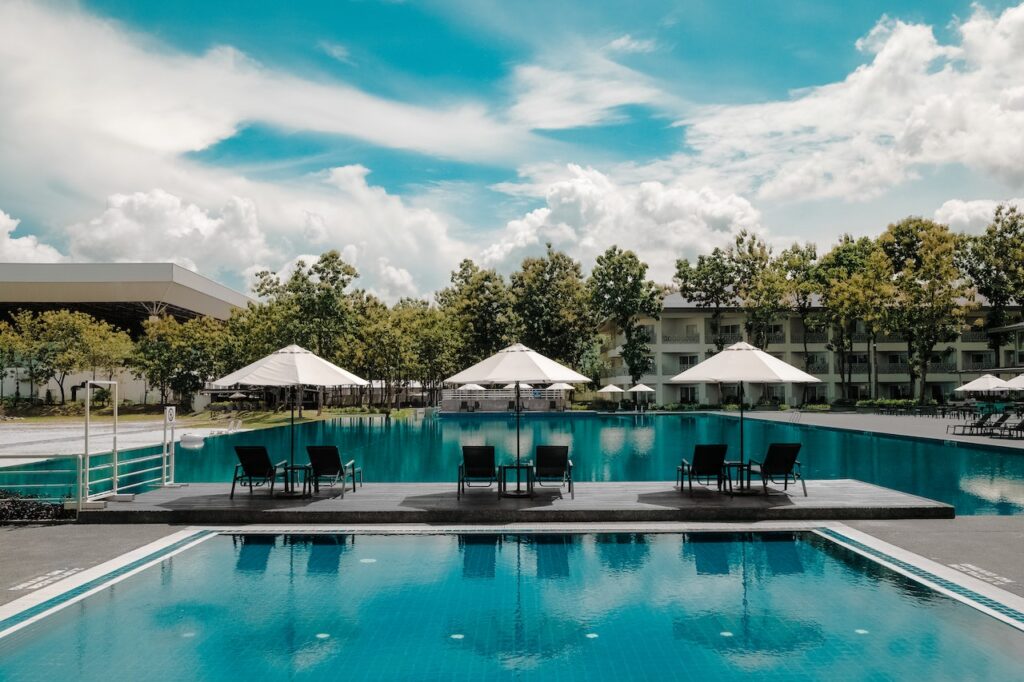
- A heated pool
A holiday staple, the swimming pool can be one of the things any holidaymaker looks forward to the most, and it’s always best practice to check that your destination has one before you book. Discovering something so disappointing after money has changed hands, or even after arrival, can be a low note on which to start a holiday!
- A spa
If you’re after a true rest and relaxation break, there’s nothing that beats an in house spa. Whether you’re a sauna person or a hot tub person, a massage person or a mud bath person, you won’t be able to help but come back from your holiday refreshed.
- Excursion packages
Caught between wanting to explore but not wanting to do a whole bunch of planning? You should look for hotels which offer excursion packages. Excursions are run by a professional tour guide who can take you to all the best local spots, and they often know a few hidden gems you might not find on your own as well – all without you having to lift a finger. Just don’t miss the bus back!
- Fitness resources
Even if you aren’t intending to keep to your normal gym or fitness routine, it can be fun to indulge in some sporting activities while you’re on holiday, as a fun diversion with friends or simply to get your body moving. Many hotels offer features such as gyms and fitness classes if you’re hoping to get a few individual workouts in, but more commonly you can find features like tennis courts, more often than not complete with equipment like tennis rackets and balls as well. Just bring your kit!
5. Detectors
The integration of various detectors in a hotel is essential for ensuring the safety, security, and well-being of guests and staff. Fire detectors, such as smoke and heat sensors, play a critical role in early detection and swift response to potential fire hazards, safeguarding lives and property. Carbon monoxide detectors are crucial in monitoring indoor air quality and preventing the silent threat of carbon monoxide poisoning. Additionally, motion detectors and security cameras enhance overall security by detecting unauthorized access and providing surveillance. Water leak detectors can mitigate the risk of water damage by promptly identifying leaks and preventing potential disruptions to hotel operations. Also, a vape detector feature in a hotel is of paramount importance in maintaining a safe and healthy environment for guests and staff alike. As vaping has become increasingly prevalent, especially among younger demographics, the potential for misuse in indoor spaces poses various risks. A vape detector helps the hotel management to enforce non-smoking policies and protect guests from exposure to secondhand aerosol.
There’s so much choice out there, it can be really tricky to pick the hotel that’s right for you and your holiday. But hopefully this list has given you some pointers for features you might like that can help you come to the right conclusion!
Cancun to Tulum: A Comprehensive Travel Guide
Nestled in the eastern portion of the Yucatan Peninsula, Cancun and Tulum have gradually become popular destinations for tourists seeking to indulge in the rich Mayan history and sun-soaked beaches of Mexico. The journey from Cancun to Tulum offers travelers a taste of coastal beauty, paired with archeological wonders, providing an unparalleled experience.
Cancun, known for its turquoise waters and vibrant nightlife, serves as a perfect starting point for exploring the secrets of the Yucatan Peninsula. As travelers venture south, they discover Tulum, an enchanting town boasting well-preserved ancient ruins and pristine beaches. This captivating stretch of coast attracts history enthusiasts and sunseekers alike, making it an ideal destination for a diverse range of visitors.
The proximity of Tulum to Cancun allows for an easy and enjoyable journey between the two locations. Whether by rental car, bus, or guided tour, visitors can easily navigate the lush landscape that connects these alluring towns. Each location offers a unique experience, distinctly shaped by the region’s natural beauty and cultural heritage.

Transportation Options
ADO Bus
One of the most popular transportation options between Cancun and Tulum is the ADO Bus service. It is considered both cheap and safe for travelers. ADO buses are equipped with air conditioning, ensuring a comfortable journey. They operate frequently from Cancun International Airport to Tulum, making it a convenient choice for many travelers.
Private Transfers
Another option for getting from Cancun to Tulum is booking a private transfer. These services typically cater to individuals or groups seeking a more personalized experience. Private transfers offer the advantage of door-to-door service and can be pre-arranged, ensuring a smooth and hassle-free journey. While this option can be more expensive compared to the ADO Bus, travel insurance can sometimes cover the cost.
Taxi
Taxis are also available for those seeking transportation between Cancun and Tulum. Although this option may be less economical than the ADO Bus, it can provide a quicker and more direct route to your destination. Keep in mind that taking a taxi from Cancun to Tulum can be more expensive compared to other options, and always check the rates before boarding to avoid surprises.
Car Rental
For more flexibility and independence, renting a car is another option available at Cancun International Airport. This can be an ideal choice for those who prefer to explore the area at their own pace. Keep in mind that while renting a car is generally considered safe, it is essential to have travel insurance and be familiar with local driving regulations. Additionally, don’t forget to reserve a car in advance to ensure availability.
| ADO Bus | Private Transfers | Taxi | Car Rental | |
| Price | $ | $$ | $$$ | $$ |
| Comfort | ✓ | ✓ | ✓ | ✓ |
| Door-to-door Service | ✓ | ✓ | ✓ | |
| Air Conditioning | ✓ | ✓ | ✓ | ✓ |
| Travel Insurance Coverage | ✓ (Varies) |
Travel Time and Distance
Cancun and Tulum are two popular tourist destinations in Mexico, known for their beautiful beaches and rich cultural experiences. When planning a trip between these two locations, travelers may be interested in knowing the distance and travel time.
The distance between Cancun and Tulum is approximately 131 kilometers (81 miles). The most common route to travel between these cities is via Highway 307, a well-maintained road that connects the two destinations.
Travelers can expect the duration of their trip to vary depending on the mode of transportation they choose. Below is a breakdown of various options:
- By car: A direct drive from Cancun to Tulum typically takes around 1 hour and 45 minutes to 2 hours, depending on traffic conditions. Renting a car or using a taxi service are both options for this journey.
- By bus: Taking a bus from Cancun to Tulum is an affordable and comfortable option. The ADO Bus company operates multiple daily trips between the cities, with travel times ranging from 2 hours to 2 hours and 30 minutes.
- By shuttle or private transfer: Those seeking a more personalized experience can opt for a shuttle or private transfer service. The travel time for these services is generally similar to that of a car, at around 1 hour and 45 minutes to 2 hours.
To summarize, the distance between Cancun and Tulum is about 131 kilometers, and the journey can be made via Highway 307. Travel time ranges from 1 hour and 45 minutes to 2 hours and 30 minutes, depending on the chosen mode of transportation.
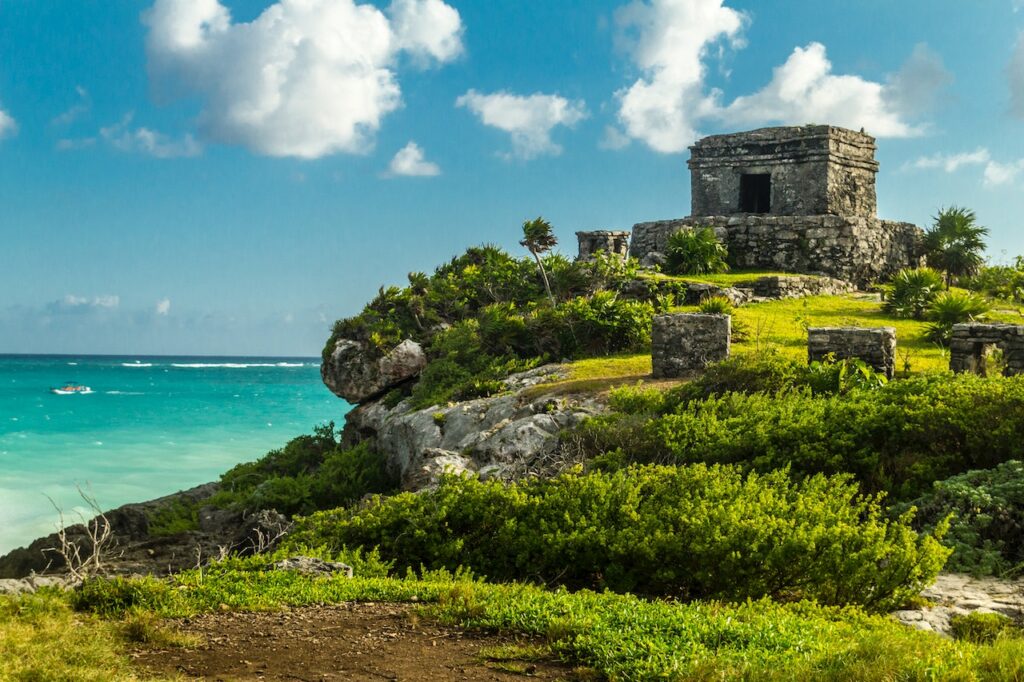
Compare Prices and Services
Cancun and Tulum, both popular tourist destinations in Mexico, offer a variety of services and price points for travelers. In this section, we will compare the major aspects such as hotel prices, transportation options, and additional services provided within these cities.
Accommodation
Hotels in both Cancun and Tulum vary in pricing and style, catering to different types of travelers. Cancun, known for its all-inclusive resorts, provides luxury options for those seeking a premium experience. Mid-range and budget accommodations are also available in the bustling Hotel Zone.
Tulum, on the other hand, is known for eco-friendly boutique hotels and beachfront cabanas, which generally tend to have higher price points. Budget travelers can find more affordable options by staying in the town center.
| Cancun | Tulum | |
| Luxury | $150 – $450 | $250 – $600 |
| Mid-range | $60 – $150 | $100 – $250 |
| Budget | $20 – $60 | $35 – $100 |
Transportation
Transport between Cancun and Tulum is quite accessible and affordable. The most common option is the local bus, called ADO, with prices averaging around $10 per one-way trip. For faster and more direct routes, the private shuttle company Playa Express also operates between the two destinations, offering some additional comfort for those willing to pay a slightly higher price.
Travelers can also rent a car to explore the region at their own pace. Depending on the car type, daily rates range from $30 to $100.
- ADO Bus (one-way): $10
- Playa Express Shuttle (one-way): $20
- Car Rental (daily): $30 – $100
Services and Tours
Both Cancun and Tulum offer a variety of activities and attractions for visitors to enjoy. In Cancun, popular services include snorkeling, scuba diving, boat tours, and exploring the nightlife. Tulum is famous for its ancient Mayan ruins, beach clubs, and yoga retreats. Prices for these activities can vary significantly depending on the operator, duration, and inclusions.
| Cancun | Tulum | |
| Water sports | $50 – $100 | $60 – $120 |
| Tours | $60 – $200 | $75 – $250 |
| Adventure | $80 – $150 | $85 – $180 |
| Other services | $30 – $100 | $40 – $150 |
In conclusion, the prices and services in Cancun and Tulum vary depending on your preferences and budget. Both destinations offer a variety of options to accommodate every type of traveler, with a wide range of activities to choose from.
Safety and Comfort
When traveling from Cancun to Tulum, safety and comfort should be a top priority for visitors. One important aspect to consider is travel insurance. Acquiring travel insurance can provide a sense of security and financial protection in case of unexpected events or emergencies during the trip.
In terms of transportation options, there are several available for travelers. Some of the popular options include:
- Renting a car
- Taking a bus
- Booking a shuttle service
- Using a private transfer
While driving from Cancun to Tulum can be a convenient option, it is essential to practice safe driving habits. Drivers should be aware of local traffic laws, speed limits, and road conditions to ensure a secure journey. Moreover, it is advisable to avoid driving at night, as visibility can be reduced and unfamiliar roads can present challenges.
For those who prefer bus travel, the ADO bus line is a safe and comfortable option. Offering air-conditioned coaches and reclining seats, ADO buses provide travelers with a reliable, worry-free way to reach Tulum. Timetables and ticket prices can be found on their official website.
Shuttle services and private transfers are another secure and comfortable means of transportation. These options offer a stress-free experience for travelers, as they provide door-to-door service without the need for navigation or driving. Prices for these services can vary depending on the provider, so it is a good idea to compare options before making a decision.
When planning a trip from Cancun to Tulum, prioritizing safety and comfort can make for an enjoyable and relaxing experience. By considering travel insurance, choosing a reliable transportation option, and being mindful of local driving practices, travelers can ensure a safe and comfortable journey.
Attractions Along the Route
As you travel from Cancun to Tulum, you’ll encounter various fascinating attractions worth exploring. Among these are Playa del Carmen, cenotes, the Riviera Maya, and the Tulum ruins.
Playa del Carmen is a popular stop along the route, offering an assortment of activities and experiences for every type of traveler. You can bask in the sun on its renowned beaches or take a stroll along La Quinta Avenida, a vibrant shopping and entertainment district buzzing with restaurants, bars, and boutique stores.
The Riviera Maya is a stretch of coastline famed for its stunning white sand beaches, azure waters, and lush tropical jungles. In this area, eco-parks, such as Xcaret and Xel-Há, provide an array of activities for visitors, including swimming with dolphins, underground river exploration, and opportunities to observe diverse flora and fauna.
Visiting cenotes, natural freshwater sinkholes, is a must for anyone traveling along the Cancun to Tulum route. These enchanting caves offer unique baptism-like experiences, as you dive into the crystal-clear turquoise waters. Some popular cenotes include:
- Gran Cenote: Ideal for snorkeling and observing marine life
- Dos Ojos: A perfect spot for scuba diving and cave exploration
- Ik Kil: Featuring a stunning waterfall and lush vegetation
The last stop before reaching Tulum is the famous Tulum ruins. Perched on a cliff overlooking the Caribbean Sea, these ancient Mayan structures give insight into the history and culture of the region. The Castillo, the Temple of the Frescoes, and the Temple of the Descending God are key highlights of the site. Don’t forget to take some time to relax on the pristine beach adjacent to the ruins, offering postcard-worthy views of the turquoise ocean and historic structures.
These attractions make the Cancun to Tulum journey an unforgettable experience, rich with captivating sights and marvelous landscapes.
Accommodations and Booking
Cancun and Tulum offer a variety of accommodation options for travelers. From luxurious resorts to budget-friendly hotels and private rentals, there is something for everyone.
Hotels
There are numerous hotels available in both Cancun and Tulum, ranging from budget-friendly options to five-star luxury resorts. Some popular hotel chains in the area include:
- Marriott
- Hyatt
- Ritz-Carlton
When looking for suitable hotels, visitors can use platforms like Booking.com to search for the best deals and compare prices.
Airbnb
For those seeking a more unique or private lodging experience, Airbnb is an excellent option. With a wide variety of listings, guests can choose from private rooms, entire homes or even extravagant villas. Some advantages of booking through Airbnb include:
- Personalized experience
- Local insights from hosts
- Flexibility
To explore available Airbnb listings in Cancun and Tulum, visit Airbnb and search for your desired location and dates.
Resorts
Cancun and Tulum are famous for their luxurious all-inclusive resorts. These establishments often provide guests with a comprehensive vacation experience, including accommodation, meals, drinks, and activities. Some popular resorts in the area are:
- Secrets the Vine Cancun
- Dreams Tulum Resort & Spa
- Excellence Playa Mujeres
Resorts can be booked directly through their websites or through travel agencies and booking platforms.
When planning a trip to Cancun or Tulum, it is essential to consider the variety of accommodations available and choose the one that best fits the traveler’s budget and preferences. Visitors can easily find and compare options using platforms like Booking.com and Airbnb or by conducting research on their desired hotels or resorts. With a wide range of choices, travelers are sure to find the perfect stay for their beachside vacation.
Planning Your Trip
When planning a trip from Cancún to Tulum, it is essential for travelers to consider factors such as transportation, itinerary, and travel dates to ensure a smooth and enjoyable journey.
First, decide on the travel date as it will significantly impact the overall experience. The peak season for visiting Quintana Roo, which includes both Cancún and Tulum, is from December to April. Traveling during this period offers sunny and warm weather. However, the area tends to be more crowded, and accommodations may be pricier. If travelers are looking for a more relaxed and budget-friendly experience, they may want to consider visiting during the low season, from May to November, which brings fewer crowds and lower prices.
Once the travel date is set, it’s time to create an itinerary. Start by researching the main attractions in both Cancún and Tulum. Some popular sites include the following:
- In Cancún:
- Beaches: Playa Delfines, Playa Tortugas, Playa Norte
- Museums: Maya Museum, Museo Subacuático de Arte
- Natural Parks: Isla Contoy, Xel-Há Park
- In Tulum:
- Archaeological Sites: Tulum Ruins, Coba Ruins
- Beaches: Playa Paraíso, Playa Ruinas
- Natural Parks: Gran Cenote, Sian Ka’an Biosphere Reserve
Visitors can find helpful information on websites like Visit Mexico, Lonely Planet, or Trip Advisor to plan their itinerary and gather practical tips.
Transportation between the two cities is a crucial aspect of the trip. The distance between Cancún and Tulum is approximately 130 kilometers (81 miles) and takes about 1.5 to 2 hours by car or shuttle. The main transportation options to consider are:
| Method | Description |
| Car Rental | Pick up a car from one of the rental agencies in Cancún or at the airport terminals. Provides flexibility and convenience. |
| ADO Bus | Comfortable, air-conditioned coach buses connecting the bus stations in both cities. Affordable and efficient. |
| Shuttle | Shared or private shuttles offer pre-booked and direct service between hotel/accommodation areas. |
| Taxi/Uber | For travelers seeking a more personalized transportation service straight from their hotel or the airport. |
Overall, when planning a trip from Cancún to Tulum, it’s important to consider the travel date, create a well-researched itinerary, and determine the most suitable transportation option. With proper planning, travelers can ensure a memorable and comfortable journey between these two beautiful cities in Quintana Roo.
FAQs and Additional Information
Bus Transportation
Many travelers ask about the schedules and ticket options for taking a direct bus between Cancun and Tulum. Autobuses de Oriente (ADO) provides three bus classes: ADO Platino, ADO GL, and Autobuses Mayab. Other companies like Autocar Cancún, Autobuses Unidos (AU), Ómnibus Cristóbal Colón (OCC), Tours Acosta, Turismo y Excursiones Alianza, and Wayak also offer service between the two locations. Check their websites or contact their customer service via phone or mail for accurate schedules, especially during peak season, as timings might change.
Car Rentals
For those who prefer more flexibility, several car rental companies operate in the area, including Discover Cars. Renting a vehicle allows travelers to explore not only Tulum Town Center and Cancun Hotel Zone but also the beauty of the Caribbean Sea and the region’s archaeological zones at their own pace. Before renting a car, make sure to read up on travel restrictions and any Covid-19-related guidelines.
Driving Directions
The fastest way to get from Cancun to Tulum is by driving along Highway 307, which runs parallel to the Caribbean Sea. The distance between the two locations is roughly 131 kilometers, and the drive typically takes about 1 hour and 40 minutes, depending on traffic.
Additional Activities
While in Tulum, visitors can enjoy a variety of restaurants, shops, and bars. Moreover, the Tulum Archaeological Zone offers a unique experience of exploring ancient Mayan ruins with a breathtaking view of the Caribbean Sea.
Smallest Country in the World: A Compact Overview
Nestled within the bustling city of Rome lies a unique and fascinating destination: Vatican City, the smallest country in the world. Encompassing a mere 44 hectares (110 acres), it boasts a rich history and serves as the spiritual center for millions of Roman Catholics worldwide. In spite of its minuscule size, this independent city-state is renowned for its cultural and religious significance.
Established in 1929, following the signing of the Lateran Treaty between the Holy See and Italy, Vatican City operates as a sovereign entity separate from its Italian surroundings. Governed by the Pope as an absolute monarchy, it functions as the headquarters of the Roman Catholic Church, showcases stunning architectural masterpieces, and houses invaluable cultural treasures.
Visitors to Vatican City are easily captivated by its iconic landmarks, including St. Peter’s Basilica, the Vatican Museums, and the Sistine Chapel, which display the genius of artists like Michelangelo and Raphael. As the smallest country in the world, Vatican City not only represents the epitome of religious power but also stands as a testament to human creativity and cultural significance in a compact space.

Top 10 Smallest Countries
Vatican City
Vatican City, also known as the Holy See, is the smallest country in the world with an area of just 44 hectares (110 acres) and a population of around 800. It is an independent city-state and serves as the spiritual and administrative center of the Roman Catholic Church.
Monaco
Monaco, a city-state on the French Riviera, ranks as the second smallest country in the world. It covers an area of 2.02 square kilometers (0.78 square miles) and houses a population of approximately 38,000 residents. Monaco is famous for its luxurious lifestyle and world-class events like the Monaco Grand Prix.
Nauru
Nauru, an island country in the Pacific Ocean, spans 21 square kilometers (8.1 square miles) with about 10,000 inhabitants. It is the third smallest country globally and has significant wealth derived from phosphate deposits found on the island.
Tuvalu
Located in the Pacific Ocean, Tuvalu covers 26 square kilometers (10 square miles) and consists of nine atolls with a population of approximately 11,000. It is the fourth smallest nation and faces challenges such as a fragile ecology and rising sea levels.
San Marino
San Marino, the fifth smallest country, is an enclave in Italy, covering an area of 61 square kilometers (23.6 square miles). With a population of around 33,000, it is also one of the oldest republics in the world.
Liechtenstein
Liechtenstein, a landlocked European microstate, spans 160 square kilometers (61.8 square miles) between Austria and Switzerland. With a population of around 38,000, it is known for its banking and financial services.
Marshall Islands
Located in the Pacific Ocean, the Marshall Islands cover 181 square kilometers (69.9 square miles) and consist of 29 atolls and five volcanic islands. The country has a population of roughly 59,000 and faces environmental challenges such as rising sea levels.
Saint Kitts and Nevis
Saint Kitts and Nevis, a two-island country in the Caribbean, encompasses 261 square kilometers (100.7 square miles). With a population of about 53,000, it is the smallest sovereign state in the Western Hemisphere.
Maldives
The Maldives, an island nation in the Indian Ocean, covers 298 square kilometers (115.1 square miles) and consists of 26 atolls. It is famous for its breathtaking natural beauty, luxury resorts, and abundance of marine life, accommodating around 540,000 residents.
Malta
Lastly, Malta forms the 10th smallest country with an area of 316 square kilometers (122 square miles). Located in the Mediterranean Sea, it is made up of three main islands with a population of about 502,000. Malta is known for its rich history, diverse architecture, and beautiful landscapes.
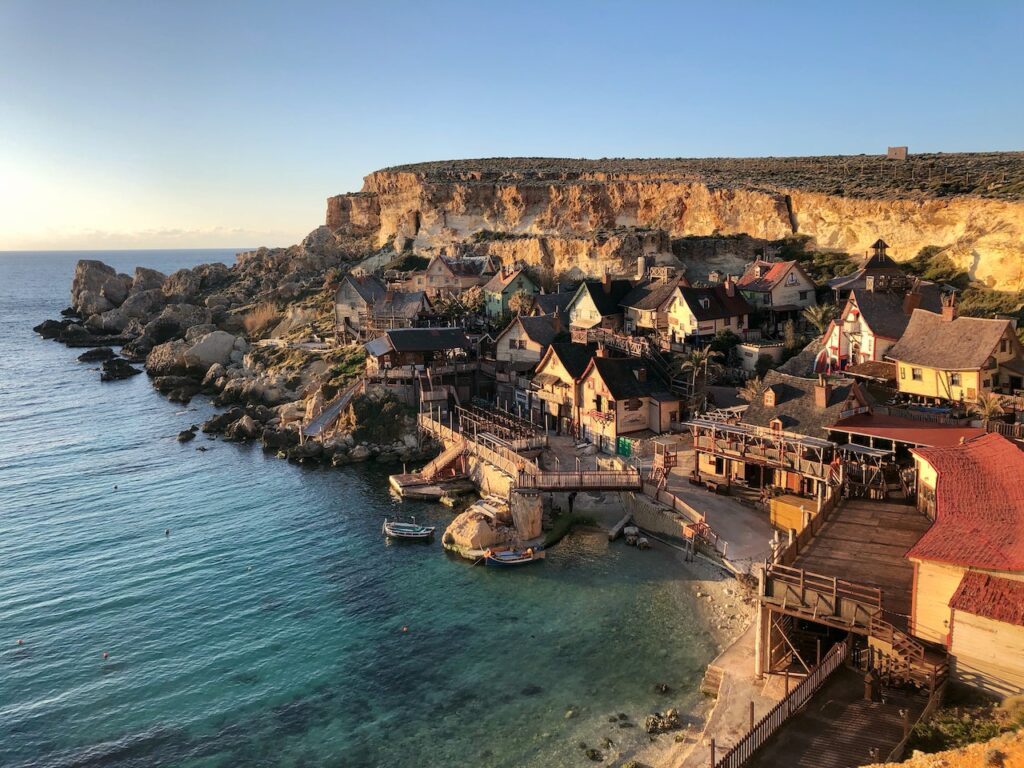
Geographical Overview
Europe
The smallest country in Europe, and in the world, is Vatican City (0.44 km²). It is a landlocked city-state entirely surrounded by Rome, Italy, and it is the center of the Catholic Church. This tiny nation holds significant religious and cultural importance, and it attracts millions of visitors annually to its historical sites, such as St. Peter’s Basilica and the Vatican Museums.
Oceania
In Oceania, the smallest country is Nauru (21 km²), a small island in the Pacific Ocean. This Micronesian country consists of just one island, but it is home to a unique culture and history. Nauru’s economy heavily relies on phosphate mining, which has led to severe environmental degradation over time.
Caribbean
The smallest country in the Caribbean is Saint Kitts and Nevis (261 km²). This two-island nation is known for stunning sandy beaches and lush tropical landscapes. The islands are of volcanic origin and have a rich history, including the remnants of sugar plantations that date back to the colonial era.
Indian Ocean
The title for the smallest country in the Indian Ocean goes to the Maldives (298 km²). It is an archipelago of 26 atolls, comprising over 1,000 coral islands. Renowned for its idyllic beaches, vibrant coral reefs, and diverse marine life, the Maldives is a popular tourist destination. Due to its low altitude, the Maldives faces significant risks associated with climate change and rising sea levels.
Factors Defining a Microstate
Land Area
A microstate is a small country with a limited land area. Generally, microstates have land areas of less than 1,000 square kilometers. For example, Monaco, the smallest country in terms of land area, covers just 2.02 square kilometers.
Population
Another defining factor of a microstate is its population size. Typically, microstates have populations of fewer than a million people. Certain microstates, like Nauru and Tuvalu, have populations of less than 10,000. This small population size allows for a close-knit community, but may also pose challenges such as limited resources and workforce.
Sovereignty
Despite their small size, microstates are typically recognized as sovereign entities with full governmental control over their territories. They have the ability to enter into international agreements and maintain diplomatic relations with other countries. However, the small size and limited resources of microstates can lead to a reliance on larger neighboring countries for support in areas such as defense and foreign policy.
In summary, microstates are small countries characterized by their limited land area, small population size, and sovereign status. These factors contribute to the unique challenges and opportunities faced by these tiny nations.
Economies and Political Systems
The smallest country in the world, Vatican City, has a unique political and economic system. As a theocratic absolute monarchy, it is governed by the Pope, who has full legislative, executive, and judicial power. The economy of Vatican City is primarily supported by donations from Roman Catholics worldwide, tourism, and the sale of publications, coins, and postage stamps.
Some other small nations also have distinct political and economic systems. For example, the Republic of San Marino is the world’s smallest republic, with an area of just over 61 square kilometers. Its political system is based on a combination of parliamentary and direct democracy, with two Captains Regent serving as heads of state. The economy relies mainly on tourism, the sale of its collectible coins and stamps, and its VAT-free status, attracting shoppers from neighboring Italy.
Another interesting case is the Commonwealth Realm of Tuvalu, consisting of nine small islands in the Pacific Ocean. As a member of the Commonwealth, its head of state is Queen Elizabeth II, and it has a parliamentary system of government. Tuvalu’s economy is primarily based on:
- Fishing and agriculture
- Tourism aimed at eco-travelers and adventurous visitors
- The lease of its internet domain, .tv, which generates significant revenue
In general, these smallest countries in the world tend to have limited natural resources and small populations, which can pose challenges to their economic development. Nevertheless, they often find creative ways to leverage their unique geography, political systems, or other assets to support themselves and maintain a high standard of living for their citizens.
Threats to Smallest Countries
Climate Change and Rising Sea Levels
One of the major threats facing the smallest countries in the world is climate change and rising sea levels. As global temperatures continue to rise, glaciers and ice caps are melting, causing the sea levels to rise at an alarming rate. This becomes a significant issue for small island nations, such as Tuvalu and the Maldives, which are only a few meters above sea level.
These countries are extremely vulnerable to the effects of climate change. Coastal erosion, flooding, and saltwater intrusion into freshwater supplies are common concerns. Additionally, extreme weather events, such as storms and hurricanes, can cause further devastation to these nations.
Loss of Sovereignty and Independence
Another threat that smallest countries face is the potential loss of sovereignty and independence. Due to their small size and often limited resources, these countries can be more vulnerable to external pressures, such as economic coercion or military aggression from larger nations.
In some cases, these pressures can lead to a loss of political autonomy, as small countries may be forced to make concessions in order to maintain good relations with larger, more influential nations. This can result in a diminished sense of national identity and pride.
Furthermore, the economic dependency on larger nations makes it difficult for small countries to diversify their economies and develop self-sufficient industries. This reliance on external support can make it challenging for small countries to maintain their independence and sovereign state status.
In conclusion, smallest countries in the world face unique and significant threats, such as climate change and rising sea levels, as well as the potential loss of sovereignty and independence.
Some Notable Microstates
Andorra
Located in the Pyrenees mountains between Spain and France, Andorra is a small, landlocked microstate with an area of 468 square kilometers. Its population is around 77,000, and the official language is Catalan. Andorra’s economy relies heavily on tourism, particularly for skiing and other winter sports, and duty-free shopping. Additionally, the banking sector contributes significantly to the nation’s GDP.
Singapore
Singapore is a city-state and island nation in Southeast Asia. With a land area of approximately 728 square kilometers, it is among the smallest countries globally. Despite its small size, Singapore boasts a diverse population of nearly 6 million people and is a global economic powerhouse. The nation has a highly developed market economy, focusing on key sectors like manufacturing, finance, and logistics. Singapore is also known for its clean streets, low crime rate, and strict laws.
Palau
Palau is an island nation located in the western Pacific Ocean, with a land area of 459 square kilometers. Comprised of around 340 islands, Palau has a small population of approximately 18,000 people. The official languages are Palauan and English. The country’s economy is primarily based on tourism, especially scuba diving and snorkeling, and the agriculture and fishing sectors. Palau is also famous for its abundant marine life and pristine environment.
Seychelles
The Seychelles is a group of 115 islands located in the Indian Ocean, with a land area of 459 square kilometers. Its population is around 98,000 people, and the official languages are Seychellois Creole, English, and French. The country’s economy is based on tourism, specifically luxury resorts, and the fishing industry, which includes exporting canned tuna. The Seychelles is also known for its stunning beaches and unique wildlife, drawing nature enthusiasts from around the world.
Trivia and Fascinating Facts
The smallest country in the world is Vatican City, also known as the Holy See. It is located in the heart of Rome, Italy, and is the spiritual center for millions of Roman Catholics. Although it is a landlocked country, Vatican City boasts some interesting and unique features.
- Total land area: With an area of only 44 hectares (110 acres), Vatican City holds the title for the smallest country not only in terms of land area but also population size, with around 800 residents.
- Rivers: Despite being landlocked and having no coastline or major rivers, Vatican City still has a water source called the Fontana dell’Aquilone in its Vatican Gardens, which provides water for its inhabitants.
- The Pope: Vatican City is the residence of the Pope, who is the head of the Roman Catholic Church and the sovereign of the country. The Pope holds absolute executive, legislative, and judicial power within Vatican City.
- Continent: Vatican City is located on the European continent and is surrounded entirely by Italy. It is the smallest member state of the United Nations by both area and population.
- European Union: Vatican City is not a member of the European Union (EU), but it maintains a unique relationship with the bloc. The Vatican uses the Euro as its official currency and has several agreements with the EU on certain matters.
- Languages: The official language of the Vatican is Italian, and Latin is commonly used in official documents and for religious purposes. English is also spoken widely among the city’s inhabitants.
- Culture: Despite its small size, Vatican City still has a rich cultural heritage. The Vatican Museums house an extensive collection of artworks and historical relics, and the iconic St. Peter’s Basilica attracts millions of tourists annually.
From its unique political status to its rich cultural and religious history, Vatican City is truly a fascinating place to learn about despite being the smallest country in the world.
How to Find a Job as an Au Pair: Tips and Strategies
Finding a job as an au pair can be a rewarding experience for those who enjoy working with children and want to experience a new culture. As an au pair, you will live with a host family and provide childcare in exchange for room and board, as well as a weekly stipend. However, the process of finding a job as an au pair can be overwhelming, especially for those who are new to the field.
To start, it is important to research reputable au pair agencies and websites that can help connect you with potential host families. These resources can provide guidance on the application process, visa requirements, and necessary qualifications. It is also important to carefully review the job description and expectations of the host family to ensure that the job is a good fit for both parties. Additionally, networking with other au pairs and families can be a valuable resource for finding job opportunities and gaining insight into the au pair experience.

Understanding the Role of an Au Pair
What is an Au Pair?
An au pair is a young person who travels to a foreign country to live with a host family and provide childcare services. The au pair typically receives free room and board, a weekly allowance, and the opportunity to study the language and culture of the host country. The term “au pair” comes from the French phrase “on par” which means “equal to.”
Benefits of Being an Au Pair
Being an au pair can provide a number of benefits, including:
- The opportunity to travel and experience a new culture
- The chance to improve language skills
- The ability to gain valuable childcare experience
- Free room and board
- A weekly allowance to cover personal expenses
Responsibilities of an Au Pair
The responsibilities of an au pair can vary depending on the host family’s needs, but typically include:
- Providing childcare services, such as playing with children, preparing meals, and helping with homework
- Light housekeeping, such as cleaning up after meals and doing laundry for the children
- Accompanying the children to school or other activities
- Spending time with the children and providing them with emotional support
It’s important for au pairs to understand that they are not professional nannies or babysitters, but rather members of the host family who provide childcare services as part of a cultural exchange program.
Overall, being an au pair can be a rewarding experience for those who are interested in childcare and cultural exchange. However, it’s important to carefully consider the responsibilities and expectations of the role before deciding to become an au pair.
Preparing for the Job Search
Determining Your Availability
Before embarking on your job search, it is crucial to determine your availability as an au pair. Consider your schedule and availability, as well as any other commitments you may have. It is also important to think about the location where you would like to work. This can help you narrow down your search and find opportunities that are a good fit for you.
Researching Au Pair Agencies
Researching au pair agencies can be a great way to find job opportunities. These agencies can connect you with host families who are looking for an au pair. When researching agencies, be sure to look for reputable ones that have a track record of success. You can also check reviews and ratings from other au pairs who have used the agency.
Creating a Profile
Creating a profile is an important step in finding a job as an au pair. Your profile should highlight your skills, experience, and qualifications. Be sure to include any relevant certifications or training you have received. You can also include a personal statement that showcases your personality and why you would be a good fit as an au pair.
When creating your profile, be sure to use a professional tone and include a clear, recent photo of yourself. This can help you stand out to potential host families and increase your chances of finding a job as an au pair.
In summary, preparing for the job search as an au pair involves determining your availability, researching au pair agencies, and creating a professional profile. By taking these steps, you can increase your chances of finding a job that is a good fit for you.

Applying for Au Pair Positions
As an au pair, you will be responsible for taking care of children and assisting with household chores in exchange for room, board, and a weekly stipend. Finding the right family to work with can be a daunting task, but with the right approach, you can increase your chances of landing your dream job.
Submitting Applications
The first step in applying for an au pair position is to create a compelling profile that showcases your skills, experience, and personality. You can do this by signing up with reputable au pair agencies or creating an online profile on popular job boards.
When submitting your application, make sure you include a professional-looking photo, a detailed resume, and a cover letter that highlights your motivation for becoming an au pair. Be sure to tailor your application to each family’s specific needs and requirements.
Interviewing with Host Families
Once your application has been accepted, you will be invited for an interview with the host family. This is your chance to learn more about the family’s expectations and to showcase your skills and personality.
During the interview, be sure to ask questions about the family’s schedule, the children’s routines, and any specific duties you will be expected to perform. It’s also important to be honest about your experience and limitations.
Negotiating the Contract
If the interview goes well, the host family may offer you a contract. Before accepting the contract, be sure to carefully review the terms and conditions, including the weekly stipend, working hours, time off, and any other benefits.
If there are any issues or concerns, be sure to negotiate with the host family to find a mutually beneficial solution. Remember, the contract is a legally binding agreement, so it’s important to be clear about your expectations and to get everything in writing.
By following these tips, you can increase your chances of finding a great au pair position that meets your needs and expectations.
Preparing for Your Au Pair Job
Acquiring Necessary Documents
Before embarking on your journey as an au pair, it is crucial to have all the necessary documents in order. These documents include a valid passport, visa, and a clean criminal record. Depending on the country you will be working in, other documents may be required, such as a medical certificate or proof of insurance.
To ensure that you have all the necessary documents, it is advisable to contact the embassy or consulate of the country you will be working in. They will provide you with all the information you need and guide you through the application process.
Packing for Your Trip
When packing for your au pair job, it is important to keep in mind that you will be living with a host family and not in a hotel. Therefore, it is recommended to pack light and bring only the essentials. Some items you may want to consider packing include:
- Comfortable clothing suitable for the climate of the country you will be working in
- Toiletries and personal hygiene items
- A laptop or tablet for communication and entertainment
- A small gift for your host family
It is also advisable to check with your host family about any specific items they may want you to bring.
Learning the Language
As an au pair, you will be working and living with a family that speaks a different language. Therefore, it is essential to learn the language of the country you will be working in. This will not only help you communicate with your host family but also help you navigate your way around the country and make new friends.
There are many resources available for learning a new language, such as language courses, online resources, and language exchange programs. It is recommended to start learning the language before you leave for your au pair job and continue to practice and improve your language skills while you are there.
By taking the time to prepare for your au pair job, you will be setting yourself up for a successful and enjoyable experience.


